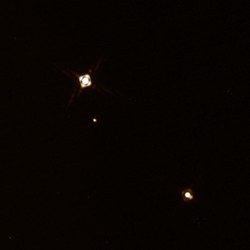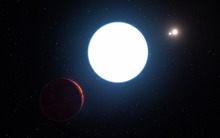 SPHERE image of HD 131399 A (top left), B and C (bottom right), and the background object (center) Credit: ESO/K. Wagner et al. | |
| Observation data Epoch J2000 Equinox J2000 | |
|---|---|
| Constellation | Centaurus |
| Right ascension | 14 54 25.30919 |
| Declination | −34° 08′ 34.0412″ |
| Apparent magnitude (V) | 7.07 |
| Characteristics | |
| Spectral type | A1V + G + K |
| Astrometry | |
| Radial velocity (Rv) | 0.30 ± 1.3 km/s |
| Distance | 351+15 −12 ly (107.9+4.5 −3.7 pc) |
| A | |
| Proper motion (μ) | RA: −30.702 mas/yr Dec.: −30.774 mas/yr |
| Parallax (π) | 9.7480 ± 0.0357 mas |
| Distance | 335 ± 1 ly (102.6 ± 0.4 pc) |
| Absolute magnitude (MV) | 1.89 |
| BC | |
| Proper motion (μ) | RA: −31.523 mas/yr Dec.: −31.047 mas/yr |
| Parallax (π) | 9.3021 ± 0.0633 mas |
| Distance | 351 ± 2 ly (107.5 ± 0.7 pc) |
| Orbit | |
| Primary | A |
| Companion | BC |
| Period (P) | 3556 ± 36 yr |
| Semi-major axis (a) | 3.56 ± 0.03″ (349 ± 28 au) |
| Eccentricity (e) | 0.13 ± 0.05 |
| Inclination (i) | 45 to 65° |
| Longitude of the node (Ω) | 265 ± 20° |
| Periastron epoch (T) | B 502 ± 33 |
| Argument of periastron (ω) (secondary) | 145.3 ± 15° |
| Details | |
| Age | 21.9+4.1 −3.8 Myr |
| HD 131399 A | |
| Mass | 1.95+0.08 −0.06 M☉ |
| Radius | 1.51+0.13 −0.10 R☉ |
| Luminosity | 14.8+2.6 −2.2 L☉ |
| Surface gravity (log g) | 4.37±0.10 cgs |
| Temperature | 9,200±100 K |
| Rotational velocity (v sin i) | 26±2 km/s |
| HD 131399 B | |
| Mass | 0.95±0.04 M☉ |
| Surface gravity (log g) | 4.40±0.03 cgs |
| Temperature | 4,890+190 −170 K |
| HD 131399 C | |
| Mass | 0.35±0.04 M☉ |
| Surface gravity (log g) | 4.45±0.05 cgs |
| Temperature | 3,460±60 K |
| Other designations | |
| CD−33°10153, HD 131399, HIP 72940, SAO 206071 | |
| Database references | |
| SIMBAD | data |
HD 131399 is a star system in the constellation of Centaurus. Based on the system's electromagnetic spectrum, it is located around 350 light-years (107.9 parsecs) away. The total apparent magnitude is 7.07, but because of interstellar dust between it and the Earth, it appears 0.22 ± 0.09 magnitudes dimmer than it should be.
The brightest star, is a young A-type main-sequence star, and further out are two lower-mass stars. A Jupiter-mass planet or a low-mass brown dwarf was once thought to be orbiting the central star, but this has been ruled out.
Stellar system
The brightest star in the HD 131399 system is designated HD 131399 A. Its spectral type is A1V, and it is 2.08 times as massive as the Sun. The two lower-mass stars are designated HD 131399 B and C, respectively. B is a G-type main-sequence star, while HD 131399 C is a K-type main-sequence star. Both stars are less massive than the Sun.
HD 131399 B and C are located very close to each other, and the two orbit each other at about 10 AU. In turn, the B-C pair orbits the central star A at a distance of 349 astronomical units (au). This orbit takes about 3,600 years to complete, and it has an eccentricity of about 0.13 The entire system is about 21.9 million years old.
One paper has reported that HD 131399 A has a companion in an inclined 10-day orbit with a semi-major axis of 0.1 AU. HD 131399 A has been described as a "nascent Am star"; although it has a very slow projected rotation rate and would be expected to show chemical peculiarities, its spectrum is relatively normal, possibly due to its young age.
Claims of a planetary system

The claimed discovery of a massive planet, named HD 131399 Ab, was announced in a paper published in the journal Science. The object was imaged using the SPHERE imager of the Very Large Telescope at the European Southern Observatory, located in the Atacama Desert of Chile, and announced in a July 2016 paper in the journal Science. It was thought to be a T-type object with a mass of 4 ± 1 MJ, but its orbit would have been unstable, causing it to be ejected between the primary's red giant phase and white dwarf phase. This was the first exoplanet candidate to be discovered by SPHERE. The image was created from two separate SPHERE observations: one to image the three stars and one to detect the faint planet. After its discovery, the team unofficially named the system "Scorpion-1" and the planet "Scorpion-1b", after the survey that prompted its discovery, the Scorpion Planet Survey (principal investigator: Daniel Apai).
In May 2017, observations made by the Gemini Planet Imager and including a reanalysis of the SPHERE data suggest that this target is, in fact, a background star. This object's spectrum seems to be like that of a K-type or M-type dwarf, not a T-type object as first thought. It also initially appeared to be associated with HD 131399, but this was because of its unusually high proper motion (in the top 4% fastest-moving stars). After subsequent data published in 2022 confirmed that the object is a background star, the paper announcing the putative discovery was retracted.
References
- ^ van Leeuwen, F.; et al. (2007). "Validation of the new Hipparcos reduction". Astronomy and Astrophysics. 474 (2): 653–664. arXiv:0708.1752. Bibcode:2007A&A...474..653V. doi:10.1051/0004-6361:20078357. S2CID 18759600.
- Høg, E.; et al. (2000). "The Tycho-2 catalogue of the 2.5 million brightest stars". Astronomy and Astrophysics. 355: L27 – L30. Bibcode:2000A&A...355L..27H.
- ^ Wagner, K.; Apai, D.; Kasper, M.; Kratter, K.; McClure, M.; Robberto, M.; Beuzit, J.-L. (2016). "Direct imaging discovery of a Jovian exoplanet within a triple-star system". Science. 353 (6300): 673–8. arXiv:1607.02525. Bibcode:2016Sci...353..673W. doi:10.1126/science.aaf9671. PMID 27386921. S2CID 206650422. (Retracted, see doi:10.1126/science.abq1709, PMID 35420970, Retraction Watch)
- Kharchenko, N. V.; et al. (2007). "Astrophysical supplements to the ASCC-2.5: Ia. Radial velocities of ~55000 stars and mean radial velocities of 516 Galactic open clusters and associations". Astronomische Nachrichten. 328 (9): 889. arXiv:0705.0878. Bibcode:2007AN....328..889K. doi:10.1002/asna.200710776. S2CID 119323941.
- ^ Nielsen, Eric L.; et al. (2017). "Evidence that the Directly-Imaged Planet HD 131399 Ab is a Background Star". The Astronomical Journal. 154 (6): 218. arXiv:1705.06851. Bibcode:2017AJ....154..218N. doi:10.3847/1538-3881/aa8a69. S2CID 55138870.
- ^ Brown, A. G. A.; et al. (Gaia collaboration) (2021). "Gaia Early Data Release 3: Summary of the contents and survey properties". Astronomy & Astrophysics. 649: A1. arXiv:2012.01533. Bibcode:2021A&A...649A...1G. doi:10.1051/0004-6361/202039657. S2CID 227254300. (Erratum: doi:10.1051/0004-6361/202039657e). Gaia EDR3 record for this source at VizieR.
- ^ Przybilla, N.; Aschenbrenner, P.; Buder, S. (2017). "Candidate exoplanet host HD 131399A: A nascent Am star". Astronomy & Astrophysics. 604: L9. arXiv:1707.07920. Bibcode:2017A&A...604L...9P. doi:10.1051/0004-6361/201731384. S2CID 119230582.
- ^ Brown, A. G. A.; et al. (Gaia collaboration) (2021). "Gaia Early Data Release 3: Summary of the contents and survey properties". Astronomy & Astrophysics. 649: A1. arXiv:2012.01533. Bibcode:2021A&A...649A...1G. doi:10.1051/0004-6361/202039657. S2CID 227254300. (Erratum: doi:10.1051/0004-6361/202039657e). Gaia EDR3 record for this source at VizieR.
- ^ Wagner, Kevin; Apai, Dániel; Kasper, Markus; Kratter, Kaitlin; McClure, Melissa; Robberto, Massimo; Beuzit, Jean-Luc (2022-04-15). "Retraction". Science. 376 (6590): 255. Bibcode:2022Sci...376..255W. doi:10.1126/science.abq1709. ISSN 0036-8075. PMID 35420970. S2CID 248180563.
- "HD 131399Ab: Astronomers Find Super-Jupiter in Triple-Star System | Astronomy | Sci-News.com". Retrieved 8 July 2016.
- Lagrange, A.-M.; Keppler, M.; Beust, H.; Rodet, L.; Meunier, N.; Lillo-Box, J.; Bonnefoy, M.; Galland, F. (2017). "Discovery of a stellar companion to HD 131399A". Astronomy & Astrophysics. 608: L9. Bibcode:2017A&A...608L...9L. doi:10.1051/0004-6361/201730978.
- "This strange new planet has three suns". CBS News. 7 July 2016. Retrieved 7 July 2016.
- Veras, Dimitri; Mustill, Alexander J.; Gänsicke, Boris T. (2017). "The unstable fate of the planet orbiting the a star in the HD 131399 triple stellar system". Monthly Notices of the Royal Astronomical Society. 465 (2): 1499. arXiv:1611.00007. Bibcode:2017MNRAS.465.1499V. doi:10.1093/mnras/stw2821. S2CID 73723946.
- "A Surprising Planet with Three Suns". ESO. Retrieved 7 July 2016.
- Miller, Michael (12 April 2017). "UC mountaineer, galactic explorer". UC Magazine. University of Cincinnati. Retrieved 3 May 2017.
- Oransky, Ivan (14 April 2022). "Triple sunrise, triple sunset: Science paper retracted when it turns out a planet is a star". Retraction Watch. Retrieved 25 April 2022.
Notes
- There are two solutions; the other one is 75 ± 10°.
- There are two solutions; the other one is 310 ± 10°.